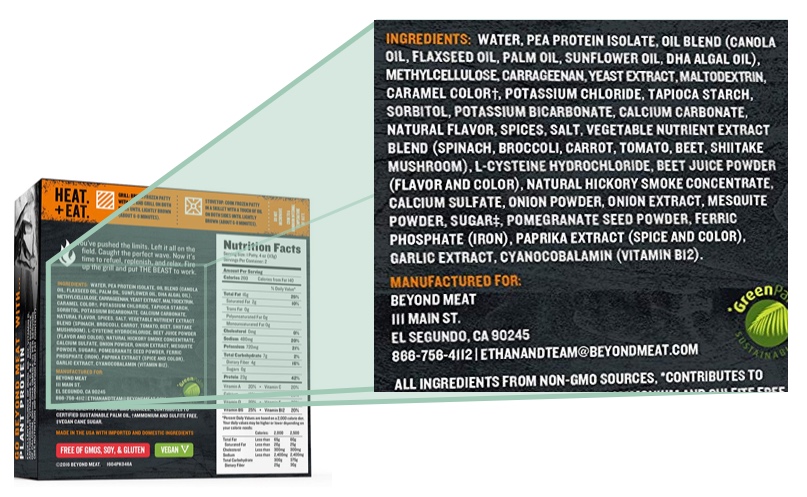
The rise of plant-based diets and sustainability concerns has led to the advent of fake meat, a term used to describe meat substitutes crafted from plant-based ingredients. While these alternatives have skyrocketed in popularity, especially with the rise of vegetarianism and veganism, it is crucial to shed light on the potential dangers lurking beneath the surface.
Most fake meat products that you find on the shelves of supermarkets are made of plant-based proteins. While that in itself sounds great, there are many hidden risks associated with fake meat. Let’s take a quick look at the health implications and environmental concerns, hopefully shedding light on the importance of mindful dietary choices.
The Health Hazards of Fake Meat: Separating Fact from Fiction
The Truth Behind Ultra-Processed Ingredients
– Fake meat is not just extracting the protein from plants, such as pea, soy, wheat protein, and mushrooms. In order to make synthetic meat look and taste like traditional meat, a ton of additives need to be infused into the product. Just go to the supermarket and have a look at the list of ingredients. It reads like a novel but many words are tough to pronounce (if you can’t pronounce it, don’t eat it). Beyond Burger and Impossible Burger for example, contain approximately 20 ingredients. Compare that to a grass-fed steak which contains just that, beef. In other words, fake meats consist of ultra-processed ingredients, including texturized vegetable protein, isolated soy protein, bleached wheat, dextrose, seed oils, modified food starch, copper sulphate, artificial flavorings and food dyes…just to name a few.

– These additives can have negative impacts on our health, potentially leading to inflammation, digestive issues, and an increased risk of chronic diseases.
High Sodium Content: A Hidden Culprit
– Many fake meat products are laden with excessive amounts of sodium, oftentimes six times more than ordinary meat, which can contribute to high blood pressure and cardiovascular problems.
– Consuming fake meat regularly without monitoring sodium intake may pose significant health risks, especially for individuals with pre-existing conditions.
Misleading Nutrition Claims: Looking Beyond the Label
– While fake meat products may boast impressive nutrient profiles on their labels, it is important to critically evaluate their overall nutritional value.
– Synthetic vitamins and minerals are often added to these substitutes to enhance their nutritional composition artificially, raising concerns about the bioavailability and long-term effects on our bodies.
Allergenicity and Sensitivities
– Fake meat products commonly contain soy, gluten, and other allergenic ingredients, making them unsuitable for individuals with specific dietary restrictions or sensitivities.
– Consuming these products without proper awareness may lead to allergic reactions or exacerbate existing health conditions.
Environmental Impacts: Beyond the Plate
Agricultural Footprint: The Hidden Toll
– Proponents of fake meat suggest that the increase use of synthetic meats will lessen our carbon footprint and lessen the necessity of livestock in the future. I would argue that the opposite holds true. Like many other ultra-processed foods, synthetic meat production requires extensive land use, water consumption, and energy resources. On the other hand livestock and land conservation really is a beautiful symbiotic relationship. It is important to understand the environmental benefits associated with animals roaming freely. When land is managed properly and cows are allowed to graze freely, it creates an optimal ecosystem and promotes a diverse biosphere. It supports a wide range of wildlife, including birds, insects, and small mammals, as well as plant life, contributing to a healthy biome and sustainable agriculture.
Deforestation and Biodiversity Loss
– Meeting the increasing demand for fake meat has led to deforestation, primarily in regions like the Amazon rainforest.
– This destruction of natural habitats threatens biodiversity and contributes to climate change, counteracting the supposed environmental benefits of these substitutes.
Packaging and Waste Management Woes
– The packaging of fake meat products, often plastic-based, contributes to the global waste crisis.
– As the popularity of these alternatives surges, addressing the issue of packaging waste and promoting sustainable packaging solutions becomes paramount.
Sensible alternative for those that do not eat meat
Make your own burger! Yes, it is a little more work but at least you know what is in the dish and you can get pretty creative. There are many fantastic recipes for burgers that are based on quinoa, beans, sweet potatoes, cauliflower or eggplant just to name a few. Combined with the right ingredients you may be absolutely amazed how good a real plant-based burger can taste. Stay tuned for some amazing recipes to be posted.
In a Nutshell
While the idea of fake meat may seem enticing, it’s important to be aware of the potential health hazards and environmental impacts associated with these substitutes. Making informed decisions about our dietary choices is crucial for both personal well-being and the health of our planet.
Regardless if you eat meat or not, chose a diet that prioritizes whole, minimally processed foods and embraces a variety of plant-based options that can lead to a healthier, more sustainable lifestyle. Let’s be mindful of what we put on our plates and foster a positive impact on our health and the world around us.


